Visit: 27 June - 7 July 2002
The city
Madrid, the capital of Spain, is situated in the centre of the country. Though the Sierra de Guadarrama mountains pass to the north and west of the Autonomous Community of Madrid, the city itself is situated in a broad, flat plain 660 metres above sea level. Consequently, the city sprawls out in all directions from the centre.
Originally a Moorish fortress called Magerit, Madrid fell to Alfonso VI of Castile in the 1080s. Philip II of Spain moved the court from Valladolid to Madrid in 1561, after which it did not cease to grow in importance. Today it is the most important city in the country, rivalled only by Barcelona.
Though the city was damaged during intense fighting during the Spanish Civil War, it would eventually become the scene of Spain's rebirth as a modern country after the death of Franco and the restoration of democracy, with its celebrated movida (counterculture nightlife). Even today, its many discotheques welcome round-the-clock revelry. In the daytime, its many sights, including world-famous art museums such as the Museo del Prado, make it an important tourist destination. It was named the European Capital of Culture of 1992 and has bid for the Summer Olympic Games in 2012.
External links:
Madrid - Wikipedia
City of Madrid
The metro

Overview
| COMPARISON IN FIGURES |  |
Madrid
4 722 331 (1996) |
Metropolitan
population | Montreal
3 548 800 (2002) |
| 1919 | Inauguration | 1966 |
| 227 km | Length | 65 km |
| 190 | Stations | 65 |
| 13 | Lines | 4 |
Metrosur
April 2003 | Last
extension | Acadie station
March 1988 |
Despite Madrid's medium-sized population of 4,7 million, it possesses the sixth-longest network in the world, one which has expanded by almost a quarter in the last eight years alone. Its twelve lines plus one shuttle are run by the Metro de Madrid company under the Madrid Autonomous Community government. Madrid also has a large bus network, and its periphery is served by frequent commuter trains (Cercanías), run by the state railway Renfe and integrated with the metro at a number of points.
The majority of the network is underground, except for a short segment of lines 5 and 10 (between Lago and Eugenia de Montijo) and the line 9 extension to Arganda del Rey. The metro contains a number of garages, of which the most important is at Canillejas station in the east.
History
Construction of the metro was begun under Alfonso XIII in 1919, with Line 1 between Cuatro Caminos and Sol. By the time of the Spanish Civil War, the metro had 3 lines and 32 stations. Construction of the metro did not stop despite the war and the siege of Madrid, during which the metro served as a bomb shelter for the population.
Madrid fell to the Fascists in 1939, and Francisco Franco became dictator until his death in 1975. During his regime, the metro continued to expand, attaining 8 lines by the time of his death: 1-5, 7, Suburbano (now part of line 10), and R. (Under the Fascists, several stations were renamed, not the least prominent was the Red de San Luis station, today Gran Vía, which was renamed José Antonio for Franco's mentor, José Antonio Primo de Rivera.)
Since 1995, a massive plan (Plan de Ampliación) for the expansion of the metro has led to the construction of line 8 to provide direct service from the city centre to Barajas International Airport (including baggage check-in at Nuevos Ministerios, its downtown terminus); the construction of line 11; the extension of lines 1, 4, 7, 9, and 10; and, biggest of all, the 41-kilometre circular Metrosur line (12) serving Madrid's southern suburbs. During its construction, completed on 11 April 2003, it was the largest civil engineering project in Europe, and the largest metro extension in the world except for Seoul, South Korea.
A number of projects large and small are on the drawing boards.
Trains
The rolling stock is steel-wheeled and powered by overhead catenaries. The voltage is 1500V DC on lines 8, 10, and 12, and 600V DC on the other lines. Unlike Spanish cars, it drives on the left. The system uses only one gauge (1445 mm, one centimetre wider than international train gauge), but two body widths: the 2000-series trains used on lines 1-5 and R are 2,3m wide, and the 5000, 6000, 7000, and 8000-series trains used on other lines are 2,8m wide. The newest trains are in "boa" style.
Stations
Stations tend to be relatively plain. The older network stations tend to be done mainly in white tiles, vaguely reminiscent of the Paris metro, though many have been renovated recently. The newer stations are also plain, but have tended to be built in a very spacious style, permitting all parts of the station to be seen in order to increase the passenger's feeling of safety.
Most stations have side platforms. A number of stations, especially on the busy line 6, use the "Barcelona solution" to congestion: put platforms on either side of each rail, to allow entrances and exits on either side of the train.
Station entrances are mainly steps from the sidewalk: few stations have entrance buildings, and almost none in the city centre. Stations do not tend to be integrated with any buildings except for other transit facilities such as Cercanías stations.
Some stations have works of art, especially abstract murals and reliefs, though not usually the large, station-spanning works found in Montreal, Brussels, or Stockholm. However, Metro de Madrid has been very active in holding exhibitions of art, music, theatre, and film in its stations.
External links:
Madrid Metro - metropla.net
Metro de Madrid
History of the metro - Metro de Madrid
Metrosur - Comunidad de Madrid (in Spanish)
Photo gallery
Stations - general
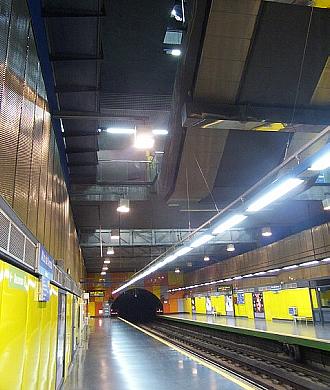 Alto del Arenal (Line 1) shows the design orientation of the most recent stations - a very large open volume allowing the passenger to see all parts of the station. (See also Art, Trains) |
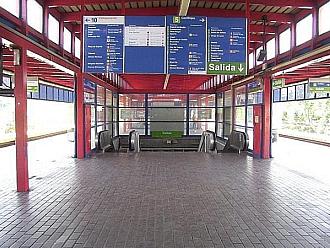 Aluche (Line 5) - For some time this was the common terminus of lines 5 and 10, until line 10 was redirected towards Metrosur and line 5 took over its southeastern branch. It was constructed to foresee its future use as a single-line station. The two lines were on either side of the island platform; when a train arrived, it would stand at the platform, and then reverse out in the appropriate direction to leave. Aluche is one of Madrid's few outdoor stations, and is also intermodal with the Renfe commuter trains. (See also Art) |
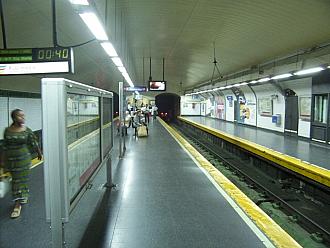 Argüelles (Lines 3, 4, 6) here shows a modified version of the "Barcelona solution" to congestion at its line 4 terminus: the tracks (one of them in this case, used for departures) have platforms on either side. (See also Art) |
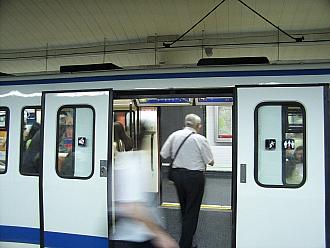 Argüelles (Lines 3, 4, 6) - A 2000-series train demonstrates the "Barcelona solution" in operation. |
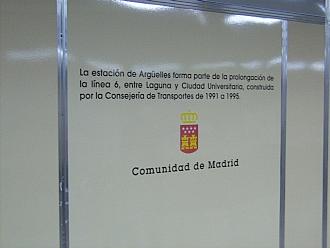 Argüelles (Lines 3, 4, 6) - Signage on the station's Line 6 platform commemorating the completion of Line 6's circuit. |
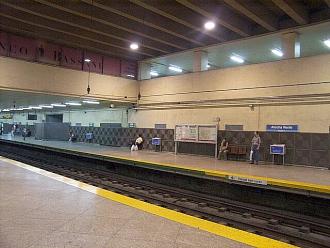 Atocha Renfe (Line 1) - This rather plain station was actually infilled between Atocha and Menéndez Pelayo to better serve the new Atocha train station, constructed just south of the former building. (See also Miscellaneous.) |
 Avenida de América (Lines 4, 6, 7, 9) has the most lines of any transfer station. Here we see the "Spanish solution" used: note the exit from the island platform through the bulkhead at the end of the platform. The sign at the bottom left says "Parada tren corto" (short train stop); shorter trains are sometimes intercalated on Line 6, indicated with vocal and display announcements. |
 Canal (Lines 2, 7) - Typical modern platform, Canal's Line 2 platform. This was originally an infill station, added to line 2 to allow transfer to the newly built line 9. |
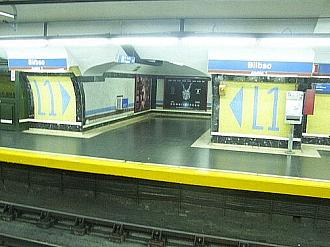 |
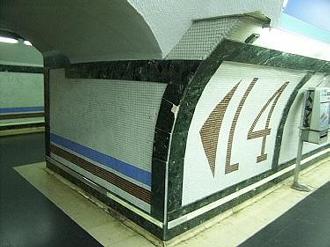 |
Bilbao (Lines 1, 4) - In addition to the normal signage, this station indicates transfer with tiled designs. |
|
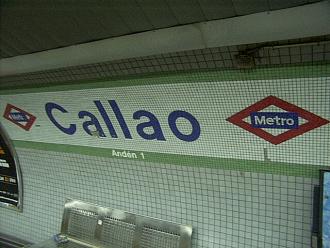 Callao (Lines 3, 5) has this interesting tiled name sign (supplemented by the standard signage.) |
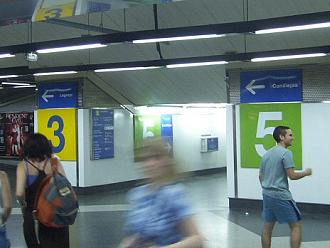 Callao (Lines 3, 5) - Highly visible and clear directional signage. |
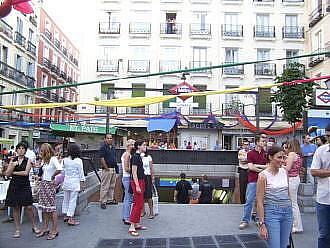 Chueca (Line 5) has its wide open-staircase entrance in the middle of the Plaza de Chueca, in Madrid's gay village of the same name (here decorated for Pride celebrations). |
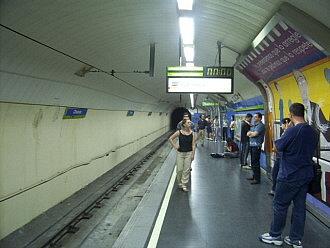 Chueca (Line 5) - Like several stations, Chueca has separated platforms. |
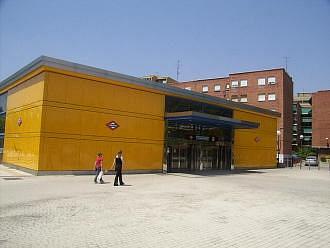 Eugenia de Montijo (Line 5), built with a tunnel at one end and open tracks (in a trench) on the other, has an entrance building, a feature found mostly among the peripheral stations. This was made possible by its position at the edge of the park of the same name. |
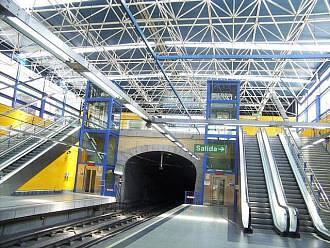 Eugenia de Montijo (Line 5) is brightly sunlit, thanks to its large glassed entrance building and shallow position. Light also enters through the track portal on the southwestern side. |
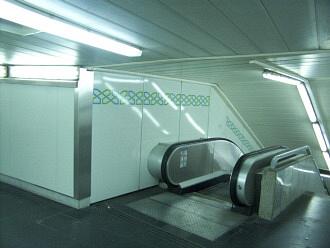 Gran Vía (Lines 1, 5) has its standard decoration supplemented with a geometrical border in the colours of the lines it serves. |
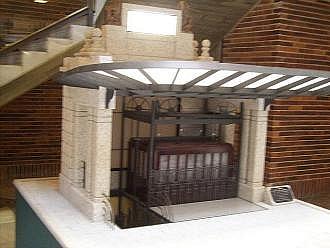 Gran Vía (Lines 1, 5), formerly called Red de San Luis, originally had an entrance building in the square of that name, as did other stations built in squares. It was nicknamed the templete (little temple) because of its shape, and this became the Spanish word for a metro entrance building. All other templetes downtown were removed in the 1930s, but the one at Red de San Luis remained until 1966. At that time, it was sent to the birthplace of its architect, Antonio Palacios, who designed the metro stations and several other buildings in Madrid in the first half of the 20th century. This replica is in the Museo de la Ciudad. (See also Art) |
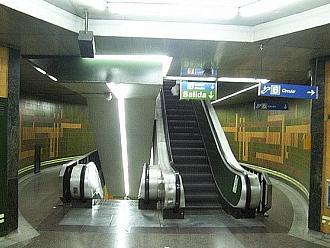 Legazpi (Lines 3, 6) - An unusually shaped and decorated escalator shaft in this annoyingly labyrinthine station. After a fire in August 2002, the stairs and passage were rebuilt with the usual modern white walls. (See also Art.) |
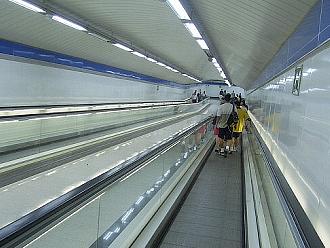 Nuevos Ministerios (Lines 6, 8, 10) - This newly installed, long, slanted moving sidewalk joins line 6 to the new terminus of line 8 to the airport. (See also Art, Miscellaneous.) |
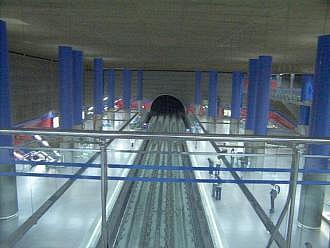 Mar de Cristal (Lines 4, 8) is a new station, built on the extension of line 4 primarily to allow transfer to line 8 to Barajas Airport. Like most new stations, it has a large volume permitting most of the station to be seen. |
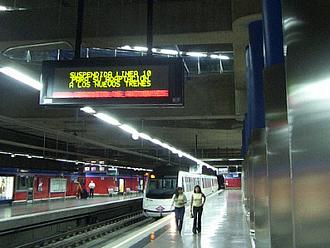 Mar de Cristal (Lines 4, 8) - Here we see the typical electronic display board found at most stations. This one is displaying a notice that part of line 10 is closed for works. The work was to enlarge the tunnels to prepare for the extension southward to serve Metrosur. (An 8000-series train poses in the background.) |
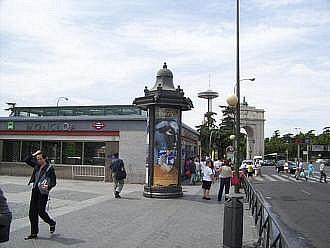 Moncloa (Lines 3, 6) - This station, in a posh part of town near the Prime Minister's residence, is one of the very few near the city centre to have an entrance building. |
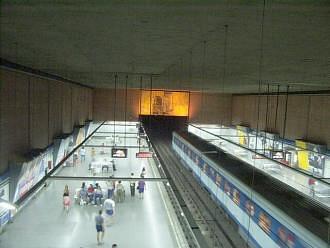 Moncloa (Lines 3, 6) - Although this station was built in 1963, this portion, serving line 6, dates to 1995, and has the modern open-cut, large volume look; this end of the platform is in tasteful muted colours supplemented by a mural. |
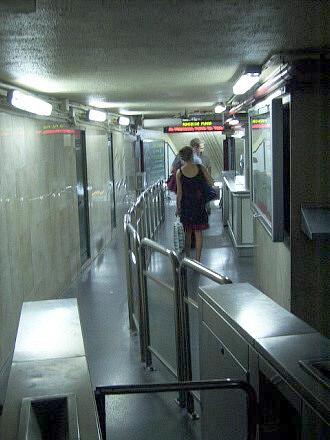 Ventura Rodríguez (Line 3) has a very narrow vestibule - so narrow that the turnstiles are too wide to be set abreast, and must be offset. The station was closed in 2005 to allow the vestibule to be widened. |
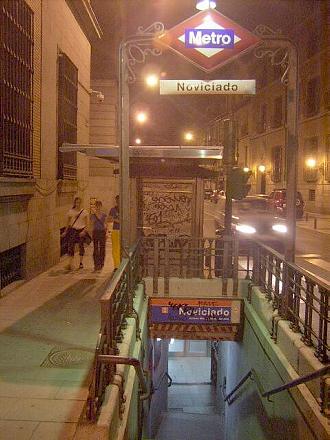 Noviciado (Line 2 - connection to Plaza de España, lines 3, 10) - This is apparently the narrowest station entrance in Madrid. (See also Art.) |
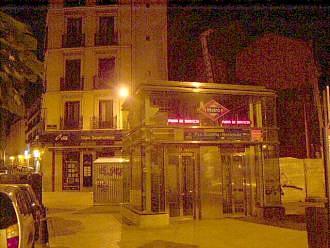 Noviciado (line 2) and Plaza de España (lines 3, 10) - All new stations are provided with elevators, and old ones are being retrofitted, such as the elevator serving these two conjoined stations. (See also Art.) |
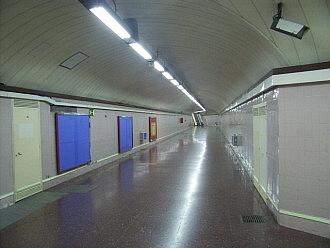 Noviciado (line 2) and Plaza de España (lines 3, 10) are linked inside the fare-paid zone to allow transfers as though they were one station, a state of affairs that also exists at Embajadores (line 3), linked with Acacias (line 5). Long transfer corridors such as this one are something of a blight in Madrid and Barcelona. (See also Art.) |
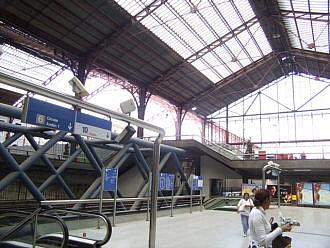 |
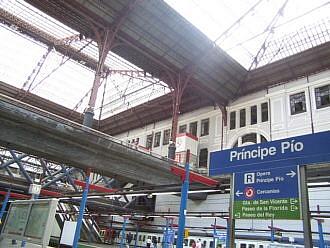 |
Príncipe Pío (Lines 6, 10, R) - This wonderful station has three metro lines, in addition to a number of Cercanías lines, all in one huge volume crossed by walkways underneath a glass roof. |
|
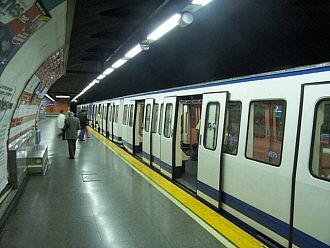 Ópera (Lines 2, 5, R) is joined by an unusual two-station shuttle to Príncipe Pío station. This shuttle, called Ramal ("branch"), was built in 1925 to provide a link to the Estación del Norte (now Príncipe Pío), then the primary train station for those arriving in Madrid from the northwest. This shot shows a Ramal train posing in Ópera station. (See also Art). |
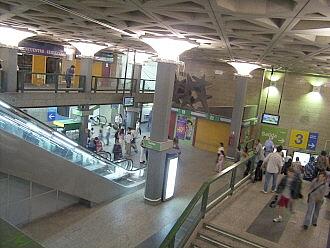 Sol (Lines 1, 2, 3) - This station, part of the first line, is built underneath the Puerta del Sol at the heart of Madrid. It has been reorganized several times. This new concourse offers shops and services as well as direct access to each of the three lines. Notice the hanging sculpture representing the seven stars of the Madrid Autonomous Community's flag. (See also Art). |
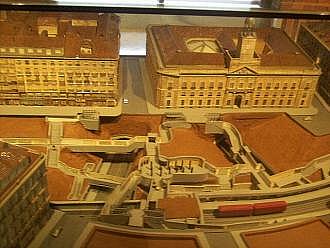 Sol (Lines 1, 2, 3) has been remodeled and rearranged extensively since its opening. Here is a model of its original configuration, exhibited at the Museo de la Ciudad. (See also Art). |
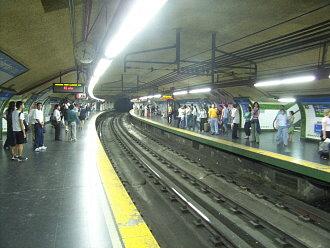 Sol (Lines 1, 2, 3) - Like a number of stations, the Line 1 platform at Sol is built in a curve, though this curve is more severe than most. Owing to structural difficulties, when the platform was lengthened to permit longer trains, the two platforms had to be lengthened at opposite ends, so now they are substantially offset. (See also Art). |
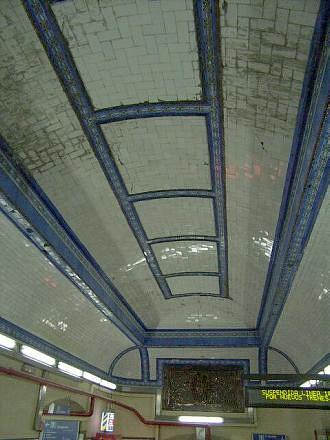 Tirso de Molina (Line 1), among the oldest stations, retains its blue and white tiling on the ceiling of the vestibule, along with a decorative boss at the end. |
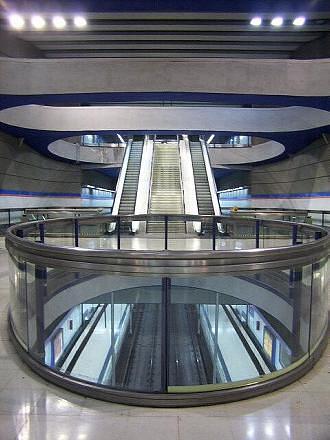 Valdezarza (Line 7) is a modern station, using openings like this to allow the view of all levels that has been de rigueur since the 1990s. |
|
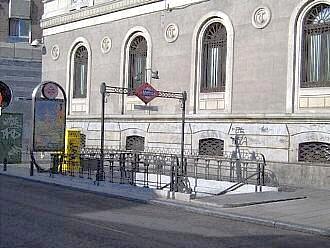 Tribunal (lines 1, 10) is capped with this entrance, typical of Madrid's open metro accesses. |
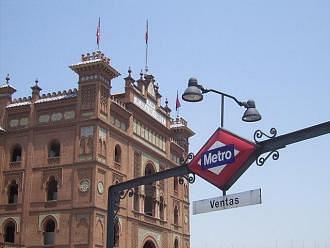 Ventas (lines 2, 5) - The Madrid metro logo superimposed over the Ventas bullring. (See also Art, Miscellaneous). |
Artworks
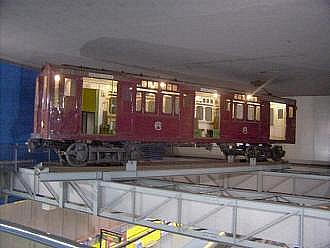 Alto del Arenal (Line 1) has a unique decoration - an old-style metro car suspended over the platforms! (See also Stations, Trains) |
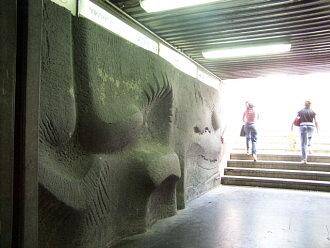 Banco de España (Line 2) - The accesses to this station (which also serve as underground walkways to cross the very wide Calle de Alcalá that leads into the Plaza de Cíbeles) are decorated with these organic-looking haut-relief murals. |
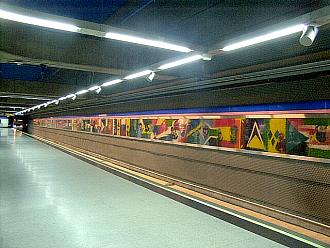 |
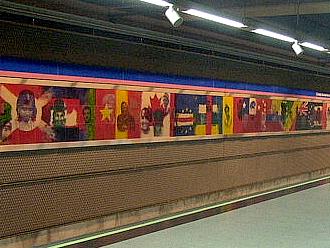 |
Campo de las Naciones (Line 8) - This station, built to serve the Madrid Fairgrounds, is thematically decorated with a mural depicting the flags and faces of the world. |
|
 |
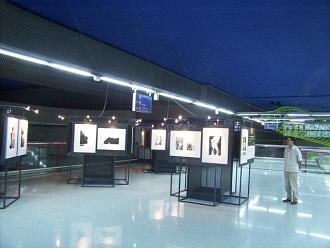 |
Much of the culture of Madrid's metro consists of temporary exhibitions of art, such as photography, dance, theatre, and music. This is an exhibition of artistic nude photographs of Spanish actors by Mexican artist César Saldívar that took place at Colombia (Lines 8, 9) in June and July 2002. Article on the exhibit (in Spanish) |
|
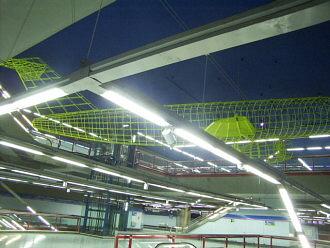 Colombia (Lines 8 and 9) - This high-tech sculpture of an aircraft suspended in Colombia station reflects that station's service of line 8 to Barajas Airport. |
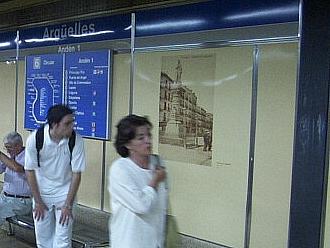 Argüelles (Lines 3, 4, 6) - The recent Line 6 platform is decorated with reproductions of historical etchings of buildings in Madrid. (See also Stations) |
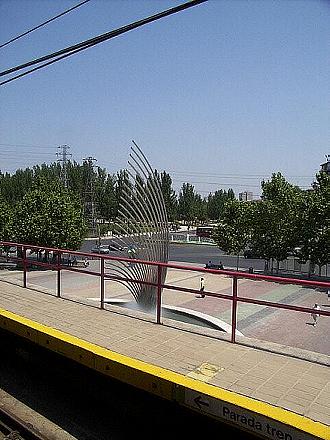 Aluche (Line 5) - The patios on either side of this station are furnished with fountains topped with identical non-representational metal sculptures, visible from the platforms, by Valencian sculptor Andreu Alfaro. (See also Stations.) |
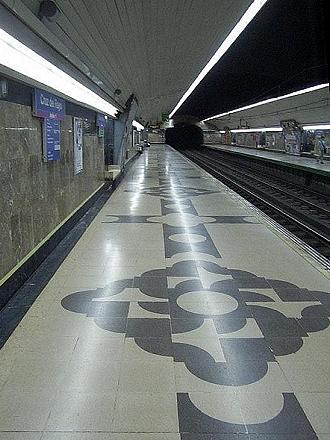 Cruz de Rayo (Line 9) - Even some stations with no artworks to speak of are distinguished by the quality of their materials; line 6 especially distinguishes itself with beautiful polished stone walls, as does this line 9 station. The intricate tiled patterns on the floor also impress. |
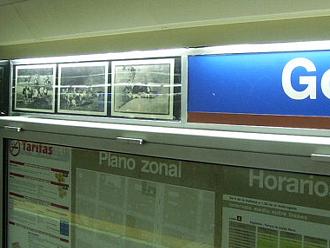 Goya (Lines 2, 4) is subtly decorated with small reproductions of the works of its namesake, Spanish master artist Francisco de Goya. |
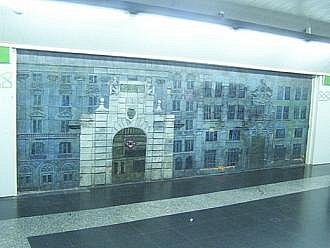 Gran Vía (Lines 1, 5) - This mural depicts the station's former entrance building or templete (see also Stations). |
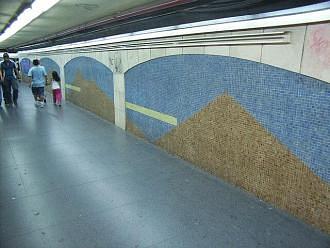 Legazpi (Lines 3, 6) is decorated with this mural in the corridor linking the two lines. (See also Stations.)
|
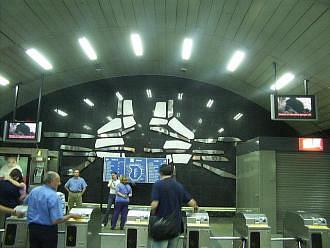 Méndez Álvaro (Line 6) - This mural is situated in the mezzanine of the station, which offers intermodal connections to the Renfe cercanías. |
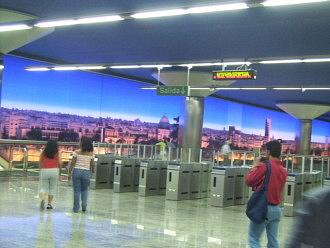 Nuevos Ministerios (Lines 6, 8, 10) - The station's new mezzanine is decorated with this huge, brightly coloured mural representing Madrid's skyline at twilight. A complementary mural in Aeropuerto station shows Madrid from the sky at night. (See also Stations, Miscellaneous.)
|
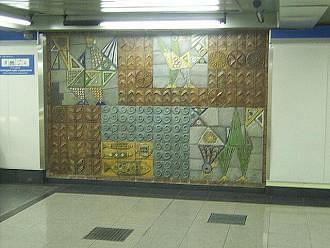 Nuevos Ministerios (Lines 6, 8, 10) - A smaller work in the same station is this relief mural in the connection to the Line 6 platform. |
 Noviciado (Line 2 - connection to Plaza de España, lines 3, 10) - These brightly coloured murals are on the station's line 2 platform. (See also Stations.)
|
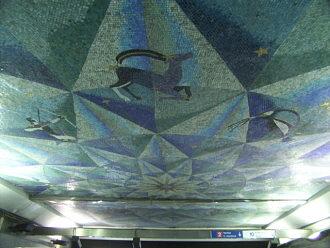 Plaza de España (Lines 3, 10 - connection to Noviciado, line 2) - The ceiling of this station's mezzanine is decorated with a beautiful mosaic depicting the signs of the Zodiac. (See also Stations.)
|
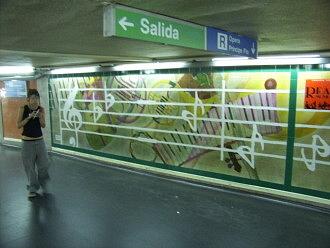 Ópera (Lines 2, 5, R) - This music-themed mural is appropriate to the station. (See also Stations.) |
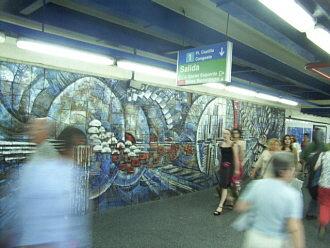 Pacífico (Lines 1, 6) - A relief and mosaic work in Pacífico station. |
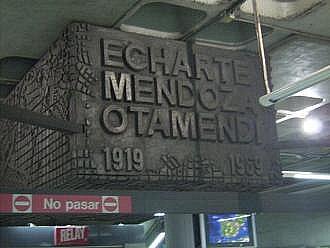 Sol (Lines 1, 2, 3), essentially being the network's central station, features a commemoration of the metro's three chief architects. (See also Stations and Miscellaneous.) |
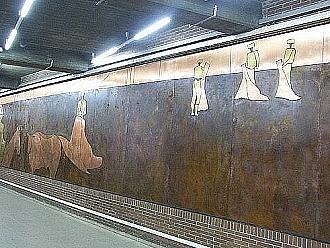 Ventas (Lines 2, 5) - The mezzanine of this station, which serves Madrid's bullring, has a bullfighting-themed mural. (See also Stations and Miscellaneous.) |
Trains
 Madrid's metro uses only one gauge, but two train body widths. This is a 2000-series narrow train. Note the lateral seating. |
 This is a 5000-series wide-body train, in use on congested line 6. Other lines have been partially reconstructed to use wider trains than they used when built. |
 This recent train, a 6000-series, is an early model of a "boa" (articulated) train, used on line 9. |
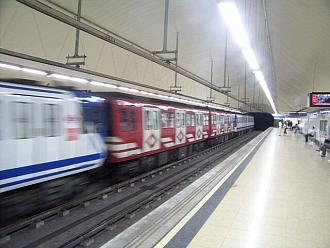 Several different liveries are used for Madrid metro trains and it is not uncommon to see cars with different liveries in the same train. However, the trains are currently being repainted in the livery of the newest cars. |
 |
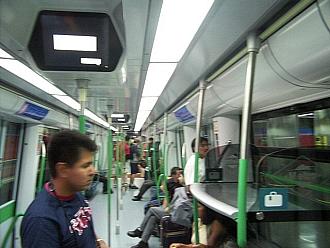 |
The most modern trains of Madrid's network, the articulated 8000 series, are used on line 8 and 12; a similar 7000 model is used on line 10, recently reconstructed to accomodate their wide bodies. They are boa-style trains with glassed cabins and television; those on line 8 are equipped with baggage racks for passengers going to or coming from the airport. |
|
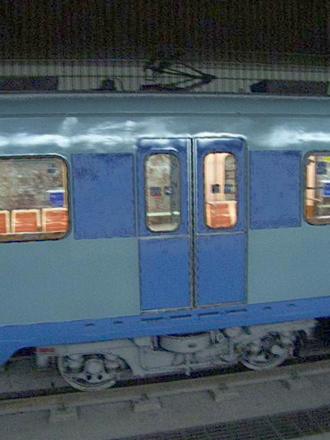 Madrid's metro operates on steel rails. As in Barcelona, there is no third rail; electric supply is overhead. This photo depicts the wheelbase of a 5000-series train. |
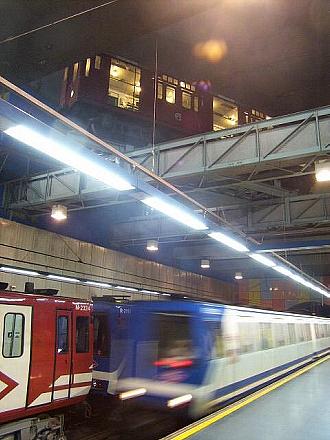 Alto del Arenal (Line 1) - Two modern trains in different liveries pose underneath the old suspended train. (See also Stations, Art.) |
Miscellaneous
 The founders of the Madrid metro: Carlos Mendoza, Miguel Otamendi, and Antonio González Echarte; portraits in the Museo de la Ciudad. (See also Art.) |
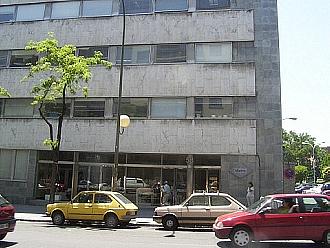 Corporate headquarters and of Metro de Madrid, near Pacífico metro. The control centre is located at Alto del Arenal. |
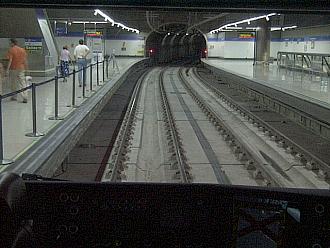 |
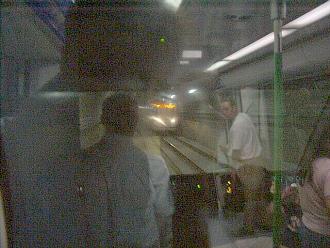 |
The glassed-in control cabins on line 8 8000-series trains afford lovely railfan views. The view of Nuevos Ministerios station was shot through the unoccupied rear cabin; the view of the tunnel through the forward cabin. |
|
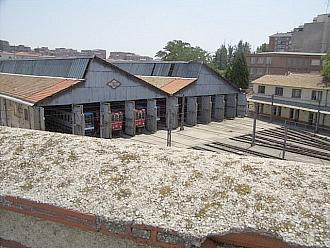 |
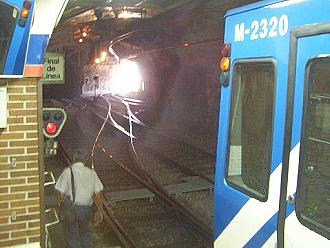 |
One of the network's cocheras (garages) is located near Ventas (lines 2, 4). It is constructed in an open-air pit surrounded by a high parapet over which one can strain to see ladder tracks and train barns. One can see the portal from the head of Ventas station, which is underground. At right, a driver walks toward the garage. (See also Stations, Art.) |
|
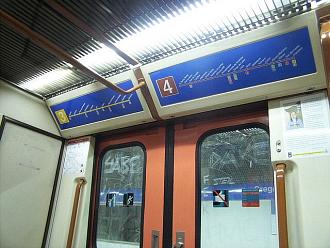 Trains contain horizontal line maps mounted above the windows and doors. |
 To distinguish between the two directions on the circular lines, the stations have large schematic maps mounted. Line maps indicate the half of the circuit closest to the station in the relevant direction. The platforms are also numbered Andén 1 and Andén 2. |
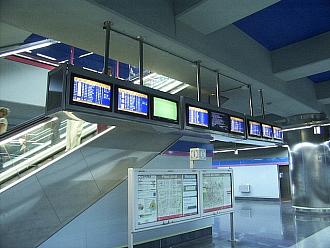 Luggage check-in for Barajas Airport is available at Nuevos Ministerios, the downtown terminus of Line 8 to the airport. The station also has this display of arrivals and departures at the airport. (See also Stations, Art.) |
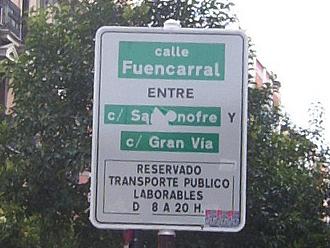 Since Madrid's downtown has many narrow, congested streets, some have to be reserved exclusively for buses during rush hour. |
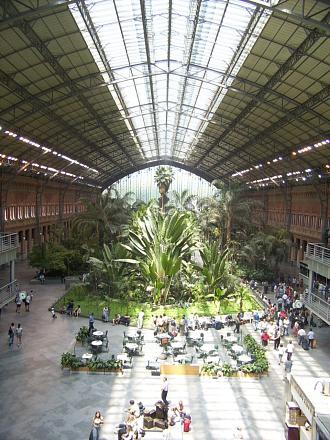
 
|
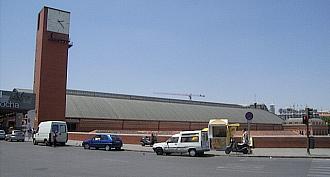 One of Madrid's two main railway terminals, Atocha, is southeast of downtown, served by Atocha and Atocha Renfe stations. It is the main station for commuter trains and for the high-speed AVE trains to Seville and Catalonia. Most other interurban and international service is to Chamartín station, in the north of the city. The original Atocha station, at left, an impressive architectural monument, had nonetheless become inadequate, so it was supplemented with the new station at right. The old station was turned into a shopping and relaxation concourse for the new station. Also, a new metro station, Atocha Renfe, was added as an "infill" southwest of the original Atocha metro station.
(See also Stations.) |
|
|






















































































